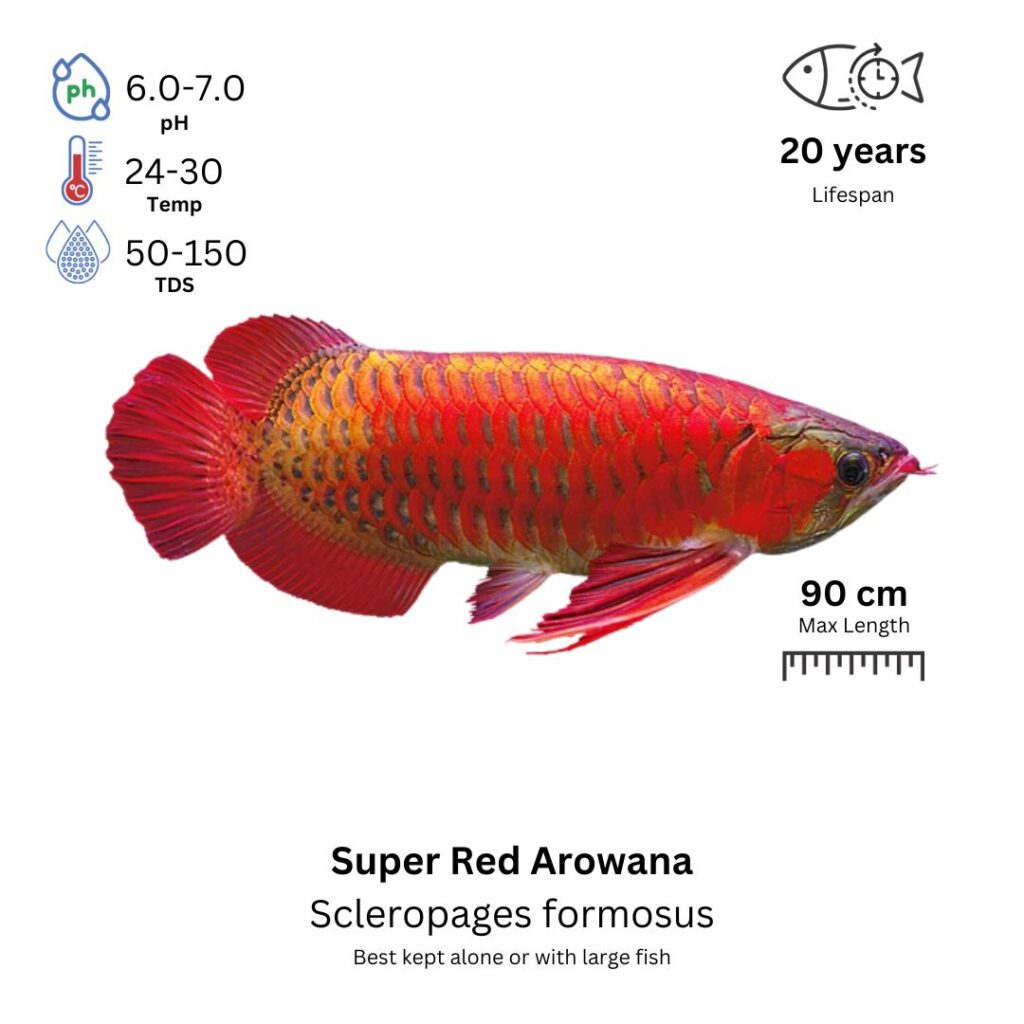Super Red Arowana
Scleropages formosus

Description
The Super Red Arowana is one of the most prized and sought-after varieties of the Asian Arowana. Known for its striking, vibrant red coloration, this fish boasts a body that gradually transitions from deep red to a bright, intense scarlet hue as it matures. The Super Red Arowana has a long, sleek body with large, elongated pectoral and dorsal fins, adding to its majestic appearance. Its scales have an iridescent shine that amplifies its brilliant red coloration, making it a spectacular focal point in any aquarium. The fish is predatory, known for its agility and acrobatic behavior, often leaping above the water’s surface when hunting. Like other Arowanas, it is territorial and can be aggressive toward other fish of similar size and temperament.
Habitat Origin
Native to Southeast Asia, particularly found in Malaysia, Indonesia, and parts of Thailand. The Super Red Arowana thrives in slow-moving rivers and streams with dense vegetation and submerged roots. These fish are commonly found in the wild in acidic, clear waters with stable water conditions.
Aquarium
Ideal Number in Aquarium: Typically kept alone or with other large, non-aggressive species, as they can be territorial.
Favorite Food

Super Red Arowanas are carnivores and are known for their hunting behavior. In the wild, they primarily feed on smaller fish, insects, and even small mammals or birds. In captivity, they are typically fed live or frozen foods like feeder fish, shrimp, and worms. High-quality pellets designed for large fish may also be part of their diet, although live food tends to encourage more natural behavior. Offering a varied diet rich in protein will help them maintain their vivid color and overall health.
Behavior:
Super Red Arowanas are solitary, territorial, and predatory fish. While they can be peaceful toward tankmates that are large enough to avoid being seen as food, they tend to be aggressive toward smaller fish. They are also known for their spectacular leaping ability and can jump out of the water when startled, so a securely covered tank is a must. As they mature, they can become more territorial and might guard their space aggressively. Super Red Arowanas are generally active swimmers, often seen gliding through the water or resting near the surface, as they are naturally surface dwellers.
Special Care:
Super Red Arowanas require a large, well-maintained tank with stable water conditions. Because they grow quite large and are territorial, the aquarium must provide plenty of open swimming space. Regular water changes, good filtration, and proper tank setup are essential to keep the water clean and healthy. The tank should have a tightly fitted lid to prevent the fish from jumping out. A well-planted or decorated tank with plenty of hiding spaces can help reduce stress and provide a natural environment. A proper diet, including a variety of live foods and high-protein pellets, will help maintain their color and health.
Compatibility with Other Fish:
Super Red Arowanas are best kept alone or with other large, robust fish that can tolerate their territorial nature. They should not be housed with smaller fish, as they may be eaten. Suitable tankmates include other large species such as catfish or large cichlids, provided the tank is large enough to accommodate both. It’s important to avoid keeping them with other Arowanas or similarly-sized fish that may compete for territory.
Breeding Setup
A separate breeding tank is essential for Super Red Arowanas due to their large size and territorial nature. Use a minimum of 150 gallons (570 liters) for a single pair, and 250 gallons (950 liters) or more for multiple pairs. Maintain pH 6.5–7.5, temperature 28–30°C (82–86°F), and hardness 4–10 dGH. Use a canister or overflow filtration system to ensure excellent water quality. A bare bottom or sandy substrate, some floating plants, and large driftwood or rocks help simulate a natural environment while keeping the space open for swimming. Use moderate lighting on a 12-hour cycle, avoiding excessive brightness.
Conditioning for Breeding
To prepare Arowanas for breeding, provide a protein-rich and varied diet including live foods (feeder fish, crickets, shrimp), frozen foods (mussels, bloodworms), and high-quality carnivorous pellets. Weekly 20–30% water changes help maintain conditions, while a larger change (~50%) and a slight temperature increase to 30°C can stimulate spawning, mimicking seasonal cues like the rainy season in the wild.
Spawning Process
Spawning typically occurs when water conditions are ideal. The male courts the female with close swimming and color display. Once the female lays 200–500 eggs, the male fertilizes them immediately. Some Arowanas may require separation post-spawning due to territorial behavior, but this depends on individual temperament. Monitor for aggression and separate if needed to protect the eggs or reduce stress.
Fry Care
Eggs hatch within 4–5 days, depending on temperature. The fry initially feed on their yolk sacs, staying near the surface. Once free-swimming, feed them infusoria or liquid fry food, and gradually offer baby brine shrimp, microworms, or fine crushed pellets. Perform daily or alternate-day small water changes (10–20%), maintain a stable 28–30°C temperature, and avoid overfeeding to protect water quality and fry health.
Key Considerations
Super Red Arowanas become sexually mature at 3–4 years. Males are slimmer with a longer, pointed genital papilla, while females are rounder, especially when gravid. During breeding, males often show more intense coloration. Avoid sudden water parameter changes, as Arowanas are sensitive to stress. Use strong filtration, keep the tank peaceful, and remove any aggressive fish that may disrupt the breeding process.
